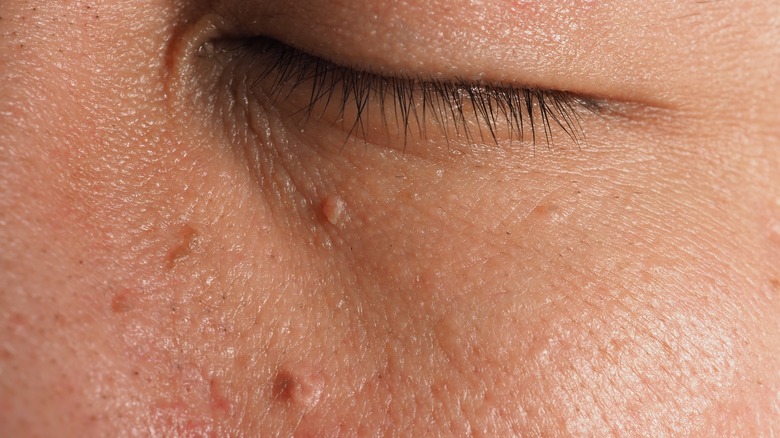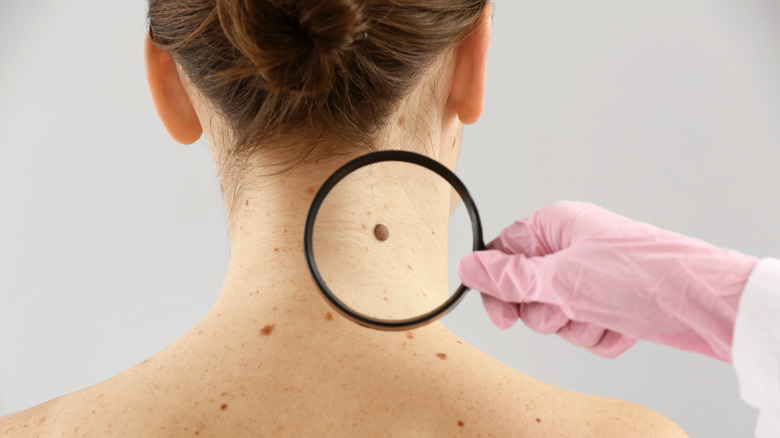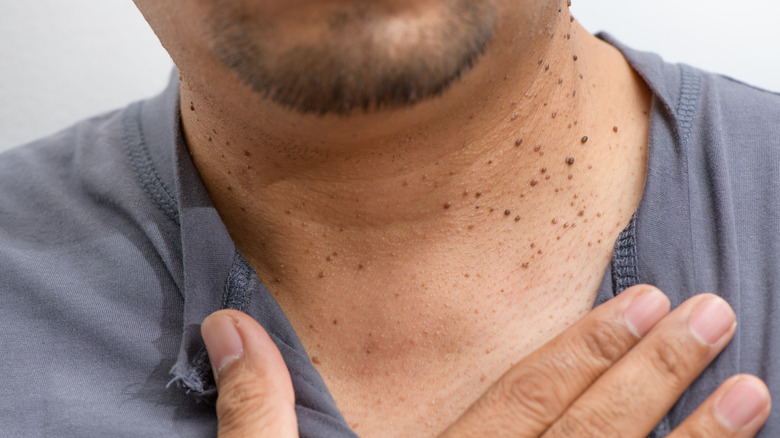Here's The Difference Between A Skin Tag And A Mole
A mole, also known as nevus, is an abnormal growth on the skin. According to the American Academy of Dermatology Association, this condition is extremely common, estimating an average of 10 to 40 moles in most people with light skin. Various factors lead to the appearance of moles on the skin. Sometimes, they're genetic, meaning moles can be present at birth (via MedlinePlus). This type of mole is called congenital nevi. Other factors that may cause moles include sun exposure, age, and drug response (via Healthline).
Moles are often mistaken for skin tags. Even though similar, skin tags have their unique structure, causes, and treatment options. According to Cleveland Clinic, skin tags (or acrochordons) are non-cancerous, painless, and harmless growths that are usually the exact color of your skin. There's no single or specific cause of skin tags. Still, the numerous risk factors include obesity, pregnancy, diabetes, and a history of family members getting skin tags, per Medical News Today.
Mole characteristics and treatment options
According to the National Cancer Institute, a common mole is usually found above the waist area. They're usually smaller than 5 millimeters or about one-fourth the width of a pencil eraser. They're also round, with a smooth surface, and are often dome-shaped. The source also states that they can appear in pink, tan, or brown colors. According to the NHS, moles are nothing to worry about. However, they may become cancerous; therefore, it's crucial to be aware of any changes in appearance or feel. They advise visiting a doctor if your mole changes color or shape or starts getting itchy.
According to Medical News Today, your doctor may prescribe one of two treatment options for mole removal: shave excision and excisional surgery. The former is a technique used for smaller moles. It involves using a small blade to cut around and under the mole. Often, this technique doesn't require sutures. On the other hand, excisional surgery or excision biopsy involves sutures after cutting the affected skin with a punch device or scalpel.
Skin tag characteristics and treatment options
According to WebMD, skin tags can be found on the neck, chest, back, under the breasts, or in the groin area. They're common in the elderly and women who have gained weight, per WebMD. Most skin tags aren't painful or dangerous but are benign, unsightly, and can be uncomfortable if clothes or jewelry rubs against them. You may not need medical attention if you aren't bothered about how your skin tags look or itch. But in cases where your skin tags, itch, bleed, or swell up, there are several skin tag remedies to consider. Visit your doctor for a proper diagnosis and recommended treatment options.
Treatment includes over-the-counter and home remedies like removal creams, freezing kits, tea tree oil, and even apple cider vinegar (via Medical News Today). But research to back the effectiveness of apple cider vinegar is still limited, and taking home remedies without a doctor's prescription might lead to scars, infections, and excessive bleeding (via Cleveland Clinic).
According to Healthline, surgical procedures for more severe skin tag cases include cauterization, cryosurgery, and ligation. Cauterization involves using heat to remove the skin tag. On the other hand, cryosurgery starts by spraying a small amount of liquid nitrogen over the skin tags freezing off the growth. Lastly, ligation involves using a surgical thread to cut off the blood flow to areas affected by skin tags.



